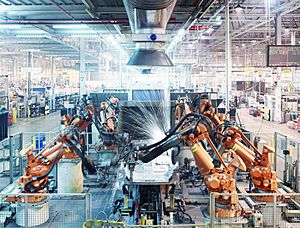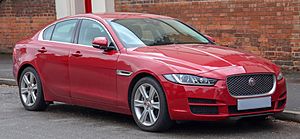Solihull plant facts for kids

The plant in 2012
|
|
| Location | Lode Lane, Solihull, England |
|---|---|
| Coordinates | 52°26′06″N 1°46′45″W / 52.435081°N 1.779191°W |
| Industry | Motor vehicle manufacture |
| Products | Land Rover Series (1948–85) Range Rover (since 1970) Land Rover Defender (1983–2016) Land Rover Discovery (1989–2018) Range Rover Sport (since 2006) Jaguar XE (2015–16) Jaguar F-PACE (since 2016) Range Rover Velar (since 2017) |
| Employees | 10,000+ |
| Architect | British Government |
| Owner(s) | British Government (1936-1945) Rover Company (1945-1968) British Leyland (1968-1986) Rover Group (1986-2000) Ford Motor Company (2000-2009) Jaguar Land Rover (2009-present) |
The Solihull plant is a large factory in Solihull, UK, where cars are made. It is owned by Jaguar Land Rover. The factory covers about 300 acres (121 hectares) and employs over 9,000 people. It is famous for building many Land Rover vehicles, including the original Land Rover and the Range Rover.
Contents
Building the Factory: 1936–1945
In 1936, the British Government bought two farms in Solihull. They planned to build a "shadow factory" there. A shadow factory was a secret factory built to make military supplies. This was done to prepare for a possible war. The factory building was finished by late 1938.
When World War II started in September 1939, the factory was given to the Rover Company. Rover was asked to build Bristol Hercules engines. These engines were used in planes like the Short Stirling bomber. The factory became a very secure place during the war. You can still find old air raid shelters on the factory grounds today. The oldest part of the factory still shows its wartime camouflage paint.
Rover Company Takes Over: 1945–1967
After the war, Rover's main factory was badly damaged. So, in 1945, the Rover Company moved to the Solihull plant. They named it The Meteor Works. Car production started again in 1946. The first new car made there was the Rover P4 in 1949.
The Solihull plant also became the birthplace of the Land Rover. This tough four-wheel drive vehicle was developed there in 1947 and 1948. The Land Rover quickly became very popular. It sold more than Rover cars from the start. Because of this, the Solihull plant has been the main home for Land Rover vehicles ever since. It has built all classic Land Rovers and full-size Range Rovers.
In 1956, a new part called North Works was added. It started as storage buildings. But by 1963, it became a full factory for the Rover P6 car. The Rover P6 even won the International Car of the Year award in 1964.
British Leyland Era: 1968–1978
The Rover Company joined with other car companies in the late 1960s. They formed a big group called the British Leyland Motor Corporation. Solihull kept making Rover cars. But the most important new car was the Range Rover, launched in 1970. Its success helped secure the factory's future.
In 1975, the factory expanded again with Eastworks. This was for the new Rover SD1 car. However, the factory faced many problems during this time. These issues affected the quality of the cars.
Focusing on Land Rover: 1978–2012
By the late 1970s, many British car brands were struggling. At Solihull, all car production stopped, except for Land Rover vehicles. Land Rover and Range Rover became a separate company based at the plant. The parts of the factory that made the Rover SD1 were closed down. Production of that car moved to another factory.
New Land Rover models were launched, like the Land Rover Discovery in 1989. The Land Rover Freelander followed in 1998. In 2000, the factory's ownership changed again. BMW sold Land Rover and the Solihull plant to Ford.
In 2005, some environmental activists from Greenpeace protested at the plant. They were concerned about greenhouse gas emissions from some vehicles, like the Range Rover Sport. They temporarily stopped production. Greenpeace said they had no issue with vehicles like the Land Rover Defender. They felt those were used more for off-road purposes.
In 2008, Ford sold Jaguar and Land Rover to Tata Motors. This company is part of the Indian-based Tata Group.
Jaguar Land Rover Today: 2013-Present
Since 2013, the Solihull plant has received a lot of new investment. This helped launch the new Range Rover in 2012 and the Range Rover Sport in 2013. A new facility was built to make car bodies from aluminium. The plant is now a "centre for excellence" for making aluminium car bodies.
In 2015, the Jaguar XE car started being made at Solihull. This was the first non-4x4 vehicle built there since 1981. The Jaguar F-Pace also started production in 2016. Famous people like Sir Stirling Moss celebrated the start of Jaguar production at Solihull. The production of the Jaguar XE later moved to another factory in 2016.
Land Rover Test Track
In 1949, a special test track was opened at the factory. This track was used to show how well Land Rover vehicles could drive off-road. It is thought to be the first track built just for public off-road demonstrations. Parts of the original track were built over as the factory grew. So, a new "Jungle Track" was added for visitors. These areas are still used today by the Solihull Factory Land Rover Experience centre.
Products Made at Solihull
Current Models
- Land Rover Range Rover (1970–present)
- Land Rover Range Rover Sport (2005–present)
- Jaguar F-Pace (2016–present)
- Land Rover Range Rover Velar (2017–present)
Historical Models
- Jaguar XE (2015–2016)
- Land Rover Series (1948–1985)
- Land Rover Defender (1983–2016)
- Land Rover Discovery (1989–2018)
- Honda Crossroad (1993–1998)
- Land Rover Freelander (1997–2006)
- Rover P3 (1948–1949)
- Rover P4 (1949–1964)
- Rover P5 (1958–1973)
- Rover P6 (1963–1977)
- Rover SD1 (1976–1981)
- Triumph TR7 (1980–1981)



